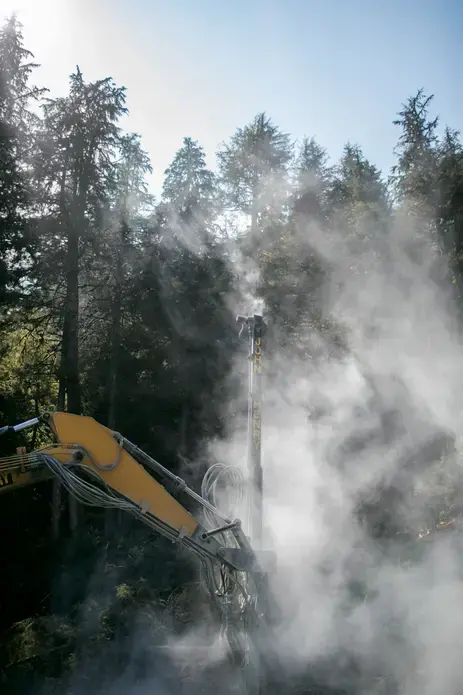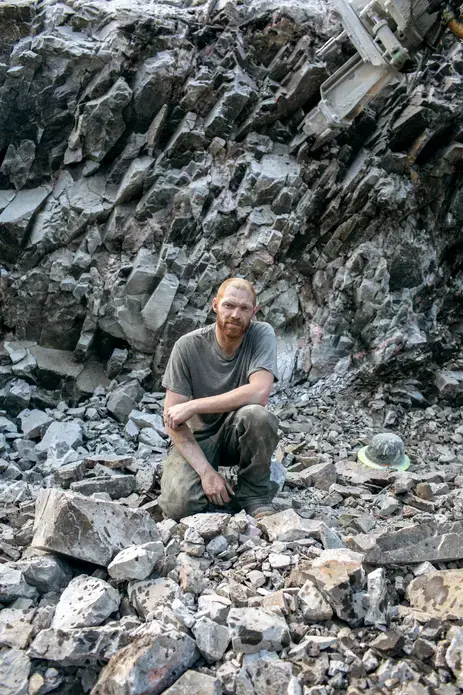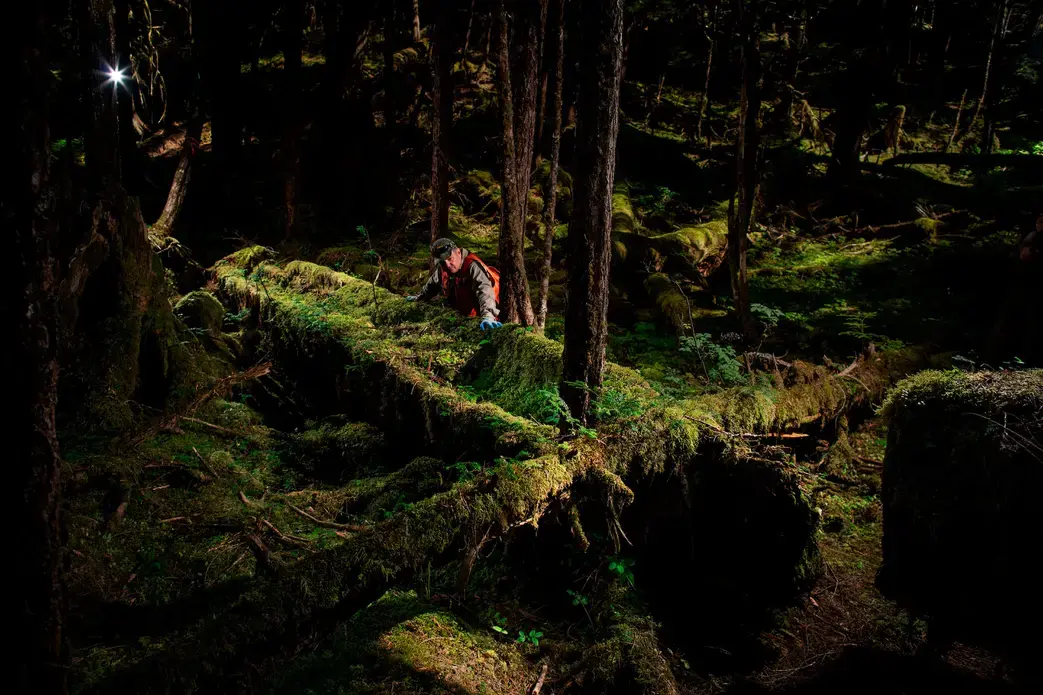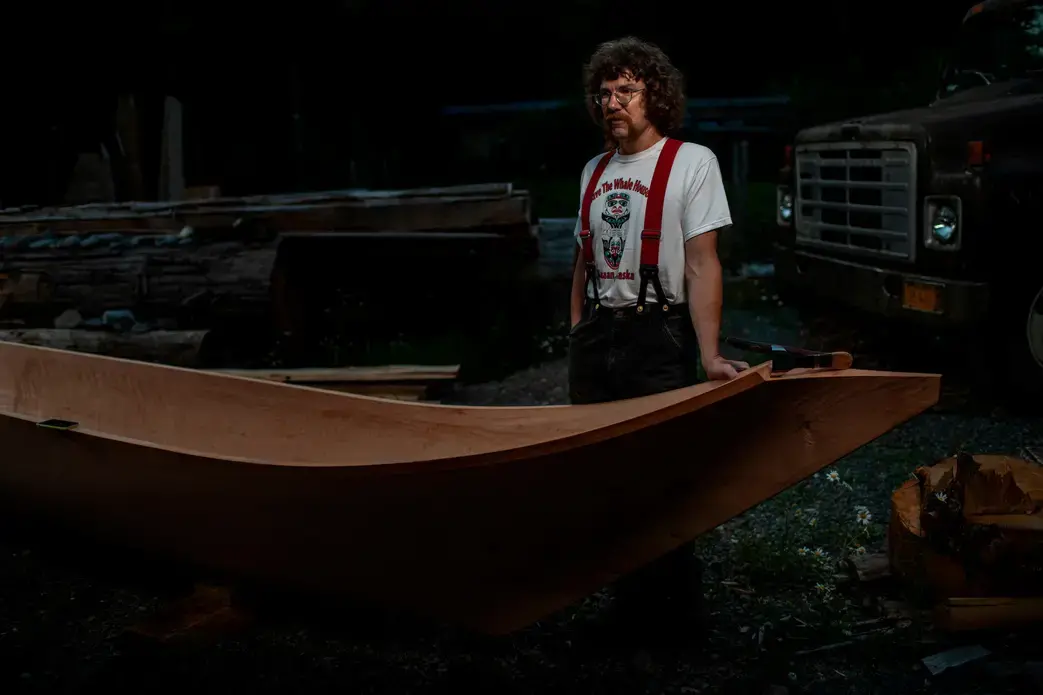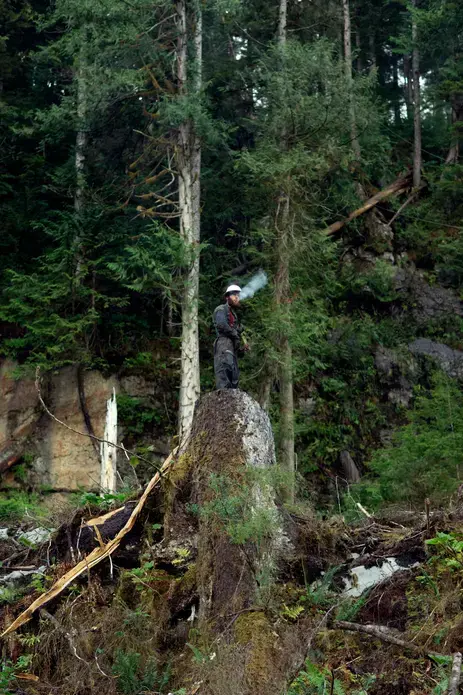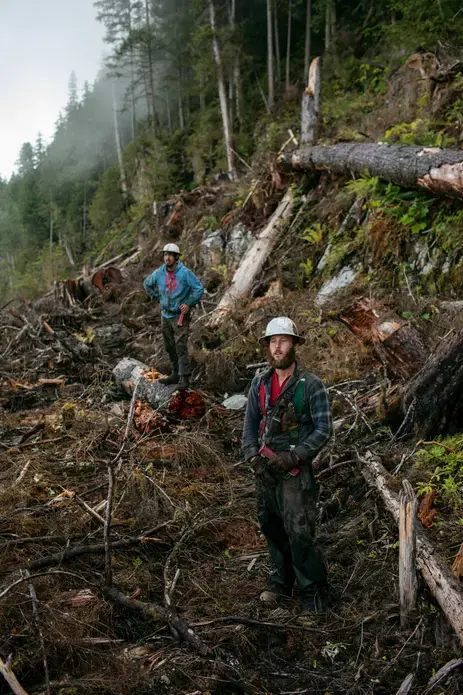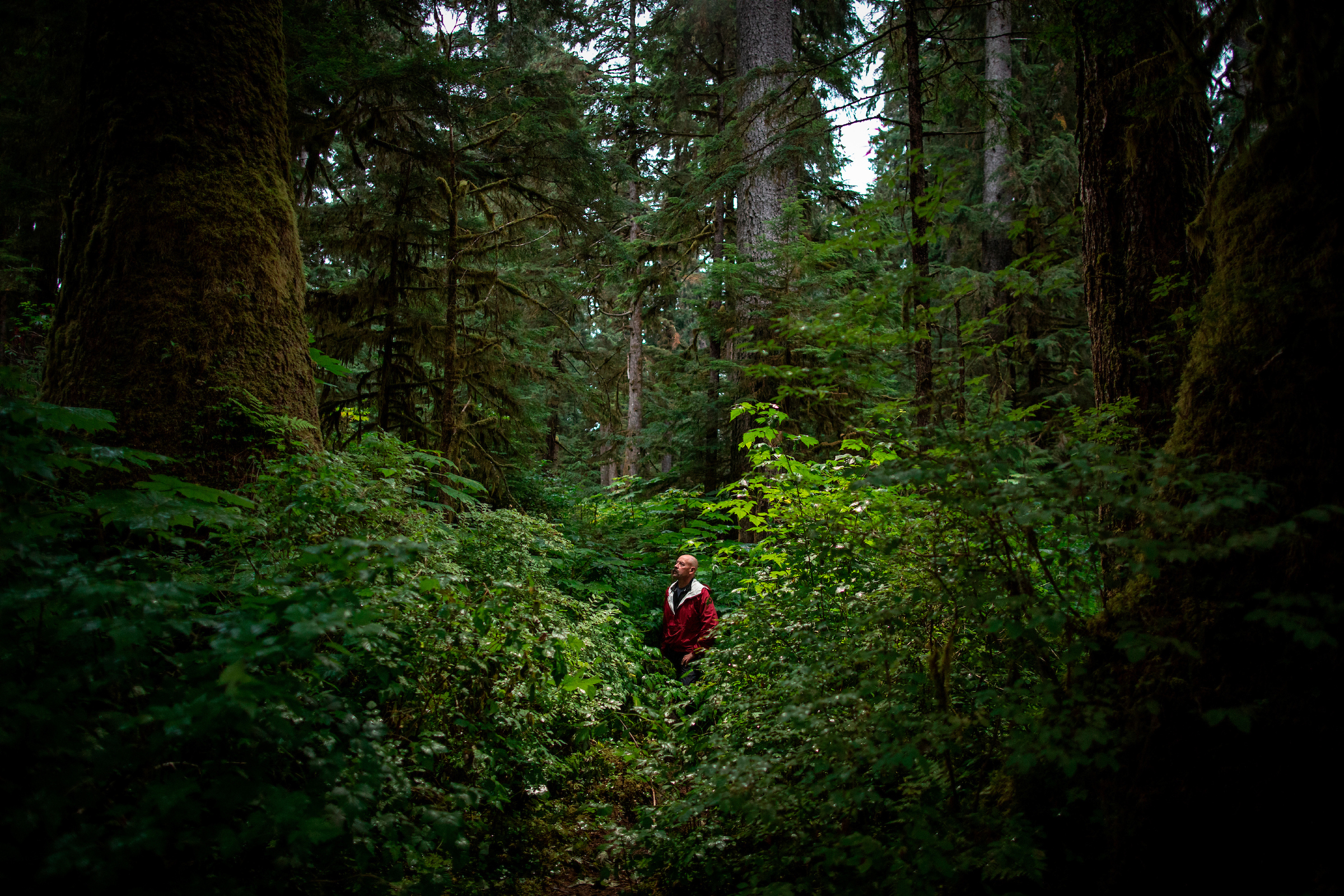
They had all tried to quit the woods, and all of them had failed. One evening after a day’s work cutting old-growth trees in the Alaska rain forest, logger Sam Parker sits in the bunkhouse with two of his coworkers, and commiserates.
In their late 20s, they are the last of a dying culture, the youngest on a crew mostly dominated by men in their 50s and 60s. The older men had gone off to their trailers—they had already had their share of late nights before four-thirty shifts—leaving Parker and his friends to sit up and rhapsodize about life in the woods.
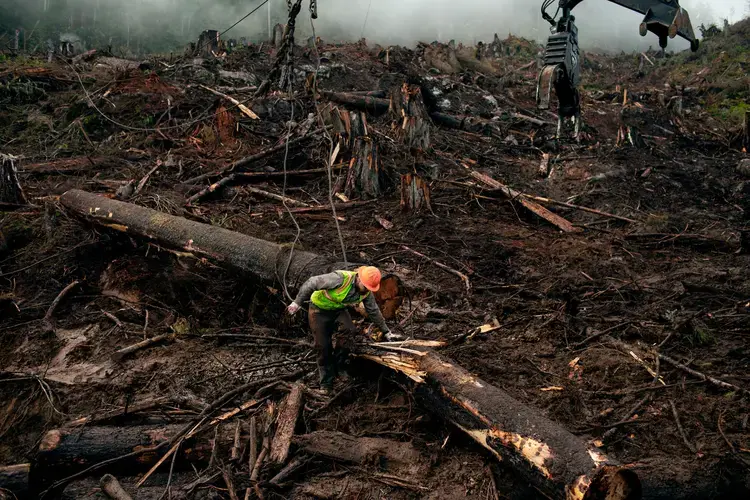
The money isn’t great, they agree, and the job is tough, the market for old-growth timber ebbing like a slow tide. And yet all agree it’s simply impossible for them to imagine doing anything else.
Parker, for his part, had been an iron worker and a construction worker, “but it only took like, took me like a couple of weeks to realize like, I don't even look forward to putting my boots on in the morning.”
In this, his attitude toward old-growth logging was rather like that of the state of Alaska as a whole: a long-running emotional attachment to a job that no longer made economic sense.

Parker works for Allied Timber, which contracts with Sealaska, an Alaska Native-owned corporation with 336,000 acres of the Tongass National Forest, America’s largest. In the Tongass, an otherworldy archipelago of primeval rain forest clinging to the misty fjords of southeastern Alaska, Sitka spruce and Western hemlock that sprouted long before Columbus arrived in the New World reach higher than a 15-story building. The vast majority of the remaining forest is old growth.
Sealaska and its trees are caught between two very different models of industrial forestry. One is young—since 2015, the company has made $100 million selling carbon credits to oil companies—and the other old: industrial-scale logging.
The national forest is also one of the last places in the country where old-growth logging is still practiced. Sam and his comrades are the last descendants of what journalist John Vaillant has called “terrestrial whalers”—the old-time lumberjacks who went into the deep woods and brought down giants.
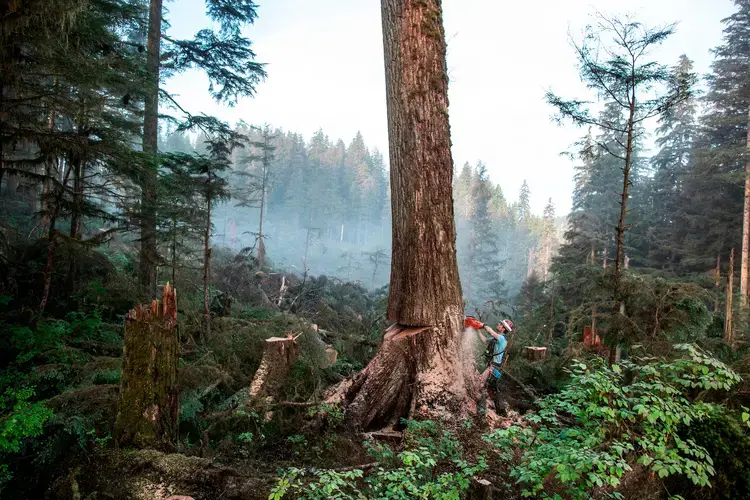
They take great pride in this work, which they sometimes define in terms of an addiction. At night, in the bunkhouse by McKenzie Inlet on Prince of Wales Island, the loggers talk about the danger and the pay—but also about the depression that sinks in when their chainsaws cut off.
In a sense, what is true for them is true for old-growth logging as a whole: It’s an industry that, for all its emotional resonance to Alaskans, hangs by a thread. It is a vestigial limb on the larger economy of Southeast Alaska, beset by the same curse as the state’s other industries: sold for too little to upgraders somewhere else.
Alaska is in many ways a third-world economy, able only to export resources that other regions turn into something else to make money from, says Anthony Malott, CEO of Sealaska. And the resources in question, kept off-line by the Clinton-era Roadless Rule, are prohibitively expensive to reach.
But in the growing awareness of the climate crisis, and the emerging carbon markets that trade credits instead of living trees, Sealaska is striking a new path: making money by not cutting trees. But as both the Trump administration and Alaska governments seek sweeping land-use changes that would open hundreds of thousands of acres of old-growth to new logging, the question remains: Does anybody want to follow Sealaska’s lead?
A land so rich
When I visit Sealaska’s corporate headquarters in downtown Juneau, snow-capped mountains loom in the background, shrouded by a December sky that’s a palette of every imaginable shade of gray. Heavy snow coats the ground for the first time in the season, a mark of how quickly the climate is changing. As recently as the 1990s, many people told me, there would have been regular knee-deep snows.
Now, every time Anthony Malott, the Stanford-educated CEO of Sealaska, flies home, there’s more rock on the mountains below, and less ice.
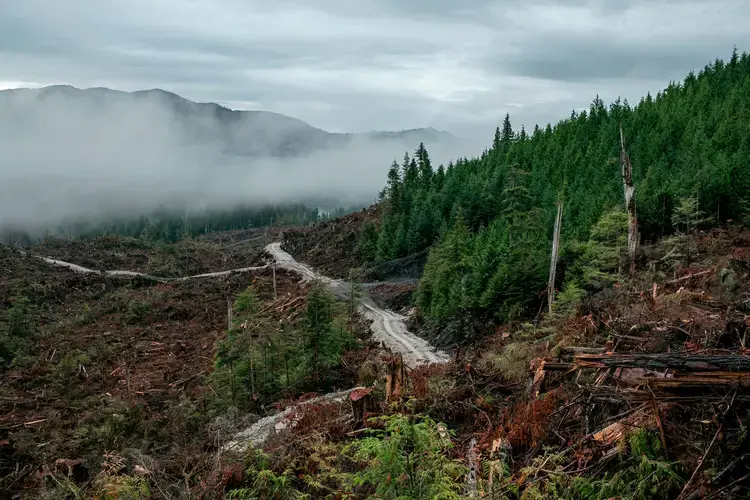
The nervousness over rapid change hangs over every conversation I have in Southeast Alaska. People talk about it as a climate refuge, “one of the last temperate places that’s going to be left,” one says. They point to the plants struggling to flower in the strange false spring of December, and the ocean turning warm, forcing the salmon north to Bristol Bay, where the cold currents they live on still swirl.
But in one important way, at least, Malott’s anxiety over shrinking glaciers means an opportunity for Sealaska: It’s now worth some money, and it has a way out of the difficult problem it’s been in, stuck with an economic system that has effectively given it no choice but to log old growth until there’s no more.
Malott is Tlingit, one of the three main Native peoples who live up and down the islands and channels of Southeast Alaska, and part of the much larger cultural grouping that goes down to Washington State. The peoples of Southeast Alaska—like their neighbors as far south as Seattle—were part of an international, but shared, world, in which Haida, Tsimshian, and Tlingit fought and traded and raided each other under a common religious and clan system. It was supervised by a form of international governance that regulated, to painstaking degree, the use of the productive, fragile forests and rivers of the Northwest Coast.
The land was so rich that the Northwest Coast people had developed settled towns and fortified cities without agriculture. They didn’t need it. Every year millions of salmon, which had spent their lives getting fat off the shrimp and eels of the North Pacific, flung themselves up the rocky streams that drain off the Coast Range, and their bodies infused energy and nutrients into the forests and the creatures that lived there.
Over the millennia, the rich, regular infusion of salmon made the Tongass trees huge, and the trees sheltered the pools that grow salmon. The land was rich enough that the pre-European human population is thought to have been about the same as it is now, regulated at regular feast-summits called potlatches, which kept the varying peoples and interests from wrecking their economic base.
What happened next is a familiar story. European disease hollowed out the tribes, killing perhaps 95 percent of their populations. In 1792 George Vancouver wrote of abandoned Northwest Coast villages full of “skull, limbs, ribs, and backbones”; the smallpox had beaten him there.
By the late 19th century, when the U.S. and Canadian administrators banned the potlatch and miners filled the depopulated Native lands, the tribes were too winnowed to resist. The old, circular economy was replaced by extractive ones. Mines sprouted in the headlands, pulp mills on the waterfront at Sitka and Ketchikan, and canneries sprung up on the salmon creeks. All of it was geared for export.
Then in 1971, the Native peoples of Alaska got a little bit of their land back in what was billed as the largest land settlement in American history: a 70,000-square-mile redress for past wrongs. But unlike in the lower 48 states, where land allotments went to reservations—effectively tiny sovereign states—in Alaska, they went to corporations that had a fiduciary obligation to make profits and give dividends to their members.
“There were a lot of people who said that was pure assimilationist,” Anthony Malott says, “but the fact was, there was a feeling the reservation model hadn’t worked well down south.”
The thought of trying to create sovereign states for 200 communities of different languages, many tiny, scattered across a state the size of Alaska, gave lawmakers pause.
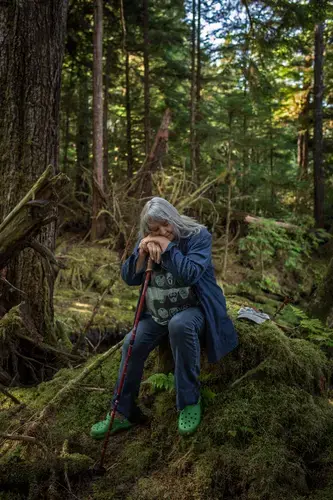
But to get the land Native negotiators had to give up sweeping fishing and foraging claims, cutting at the heart of the traditional economy. Sealaska shareholder status was determined by quantity of Indian blood (the notorious “blood quantum”), which meant it tended to disappear from families.
More significantly for the land, by putting in place the requirement to return annual profits, Congress had forced Sealaska, every year, to sell something. And thanks to Congress, they now had hundreds of thousands of acres of old-growth forest to sell.
'What have we done?'
Rain batters the plate-glass windows at the tribal council offices in Hydaburg, Alaska, on the Southwest Coast of Prince of Wales Island. It blows in off the ocean that creeps further toward the houses each year, and over the fishing boats that had once been the Haida town’s lifeblood and a key source of local identity.
Sealaska took possession of the land settlements in 1972, just as the timber boom in Southeast Alaska was getting underway, and the territory was full of loggers pushed out of Northern California, Washington, and Oregon by the so-called timber wars that saved the last old-growth stands.
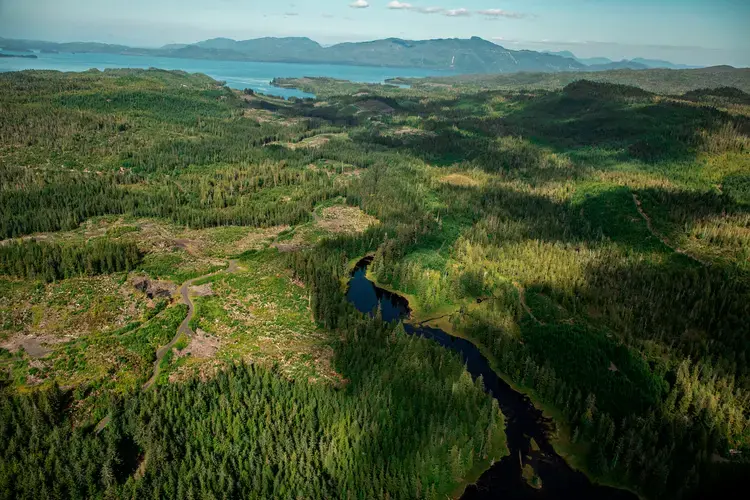
But in Alaska and neighboring British Columbia, the clear-cut was still the dominant method of harvest, particularly on Sealaska land, which as private property had less stringent environmental restrictions than the neighboring national forests. Contract crews often cut creeks to the waterline, leaving only a thin screen of trees, if that.
Logging did bring good jobs, acknowledges Tony Christiansen, Hydaburg’s longtime mayor. “But they’re the kind of shot-in-the-arm jobs,” he says. Unlike the old commercial salmon economy it largely replaced, logging was a short-term hit of cash, not a long-term sinecure.
Christiansen sits with his father, Hagu, eating a bowl of venison chili from the crockpot on the kitchen counter. Hydaburg tribal members periodically wander in, fix themselves a bowl, and head back into the rain. Hagu tells of his time as a longshoreman, loading huge trees onto barges, and of one day seeing from the air the bare ground below, and realizing what he had been part of.
“I thought, oh lord, look at my home,” he says. “What have we done?”
The logging itself was unpopular, Malott told me. Though Sealaska money paid for cultural preservation, indigenous language education, and scholarships for members at University of Alaska schools, tribal members had a deep ambivalence toward the industry, which now makes up about 30 percent of Sealaska income. Alaska Natives didn’t much want, Malott said, “to dirty their hands with it.”
Christiansen’s perspective is bleaker. “We’re taking a bath here,” he said. To the resentment over the economic costs of logging, he adds the particular unease and guilt that came with being forced to do it, an unease that kept many Natives from taking those logging jobs, and haunted some of those who had.
“It eats out the essence of your being when you go out and you decimate the environment for dollars,” he says, “and then you come back and find out that you’re not even making a whole lot of money at it.”
The clear-cuts also brought a sort of localized climate change distinct from the global one, as the trees that regulated the ecosystem disappeared, and the bare slopes left behind, washed by the constant rain, disgorged sediment into once-clear streams. Bark sloughed off from log rafts settled to the bottom and fermented into toxic methylmercury, killing the seafloor.
Now, Christiansen says, they see salmon in upland streams dying from lack of oxygen. Once-lucrative salmon streams and their attached fisheries expired as erosion from the bare hills clogged the once-clear pools, or as the loss of the canopy left them unprotected from the sun. Christiansen recalls one landslide that spilled fine glacial silt down over a once-productive crab bed, clogging their gills, killing them in place.
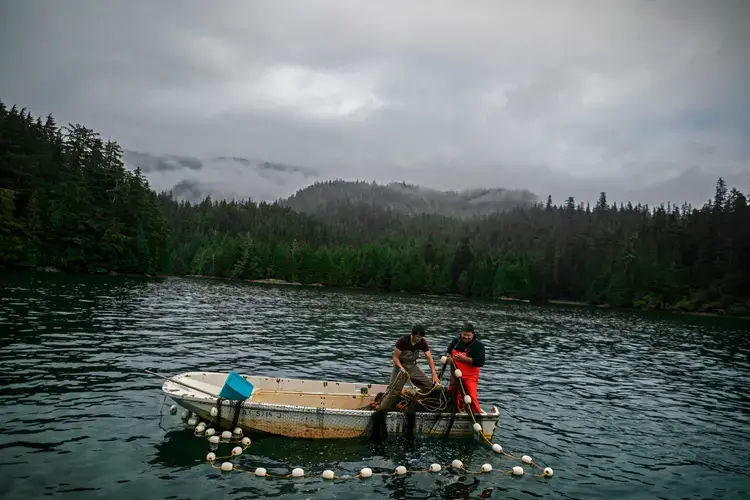
By the late 2000s, Christiansen got word of Sealaska timber scouts in the Hetta and Hydaburg Creeks, vital arteries for what remained of Hydaburg’s fishery. He called a Sealaska representative, who assured him there would be no environmental impact from the cuts. “I said, ‘You’re going to shit in our watershed and ask us to drink it’,” he says.
In the Haida homelands of Haida Gwaii, a similar proposal by Weyerhauser Corporation on Lyell Island precipitated a famous blockade that jump-started the local Haida independence movement. Eventually Sealaska, perhaps fearing a similar embarrassing blockade from its own members, agreed to leave those watersheds alone.
But they needed a solution. Sealaska was pushing into the borders of a major Haida settlement because, like the larger Tongass logging industry, they were reaching the limits of their ability to cut. And unlike the Forest Service, if they stopped logging, they risked lawsuits from their members. They were overextended in a grab bag of businesses ranging from prison guards to plastics, deep in the red.
And then California’s new carbon markets offered them a way to keep their trees and profit off them too.
Paid to not log
In its attempt to figure out what to do with its Tongass holdings, Sealaska had run up against a key conservation problem: accounting. The market has not figured out how to recognize long-term ecological value, even though that value is clearly—as in the case of the conflict between salmon streams and logging—economic. Everyone recognizes that the forests have priceless ecological value and also that, until that price can be reckoned, they will continue to be sold by the board-foot.
One attempted solution is SeaBank, a project by the Alaska Sustainable Fisheries Trust that seeks to assess the “natural capital” of Southeast Alaska’s intact forests and fisheries in hard-nosed economic terms. It’s an effort to give residents the tools to lobby for long-term, responsible management over short-term extraction.
In 2015, in a more direct solution, Sealaska won access to the California carbon-trading markets, which allowed the corporation to sell its intact forests as offsets to British Petroleum. The state’s cap-and-trade system would force electric utilities, heavy industry, and fuel distributors in the state to gradually reduce carbon emissions, with a goal of dropping 2020 emissions to 1990 levels and 40 percent below 1990 by 2030.
The “cap” part was met by heightening restrictions on emissions. The trade part allowed companies to cover up to 8 percent of their emissions through buying offsets elsewhere, at about $13 to $16 a credit. After two years of lobbying, Alaska Native corporations got their forest reserves added to the system, and BP offset their emissions by paying Sealaska not to log for the next century on 155,000 acres of the Hydaburg and Hetta watersheds, the very areas where it had once planned to cut.
Sealaska’s board, Malott said, signed this deal with some trepidation. A century is a long time. “We wanted to make sure a future board wouldn’t look at us as idiots,” he says.
The agreement with BP forces them to not log, but still allows them to clear land for hydropower or mining. While Malott says Sealaska has no immediate plans to mine its territory, the volcanic ridges of the Tongass are known to hold rich deposits of rare-earth minerals, used in high-tech devices from cell phones to Predator drones.
A more subtle, but potentially bigger, risk is that Sealaska has sold out cheap. The 2015 sale came before years of superstorms and wildfire had begun to drive home the reality of climate change. It seems likely that as the pressing need for restricting emissions grows over the coming decades, the price of carbon will only increase (although presumably the supply will too). Professor Niall Mac Dowell, of Imperial College London, has estimated that a carbon price of $75 per metric ton is needed to make large-scale carbon capture an economically viable industry.
That is five times what Sealaska got in 2015. “The only way not to get screwed on carbon price is,” Malott says, “don’t spend it all.” If the money were productively invested and Sealaska lived responsibly off the interest, he says, then the price difference wasn’t such a big deal.
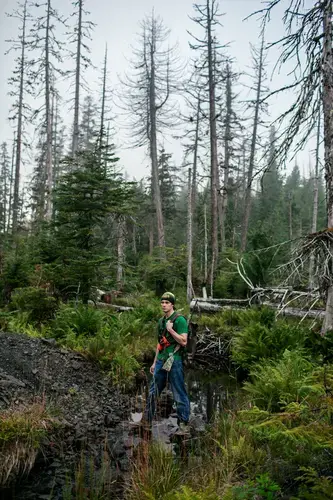
In selling the carbon rights to this land, Sealaska is forgoing potential logging fees: The value per acre of selling their trees is currently only about 10 percent of what could be raised from a timber sale. Still, even here, carbon credits hold certain advantages. Unlike logging, carbon credit sales leave the forest for trapping, hunting, and salmon spawning. Credits require limited investment of capital to recoup.
And perhaps most usefully, carbon landscapes can make money without the risk of conflict. In the macro sense, this means avoiding the holdups caused by expensive, protracted litigation from citizen and environmental groups. It’s a serious concern in the Tongass, where in September a federal judge blocked an attempted U.S. Forest Service sale of 1,200 acres of old-growth trees.
But in the micro, and perhaps more important sense, it keeps peace. Carbon credits had mitigated the potential rift over the trees in the Hydaburg watershed, allowing multiple interests to live from the same land, just as in the days before European settlement.
A push for more logging
The irony of Sealaska’s business plan is that carbon sales may actually be better business than old growth logging, especially once you figure in the difficulty of getting the timber out or getting your sale through the gauntlet of environmental groups that are likely to sue.
“I use [Sealaska] as an example when I write comments to the Forest Service,” says Bob Claus, a former Alaska State Trooper and forest activist who has spent much of his life on Prince of Wales. “It’s useful to be able to say: ‘'Okay, this is what Sealaska is doing. We think it's great they're talking from a conservation point of view. So if Sealaska is doing carbon credits to monetize the old growth, why isn't the Forest Service?”
One reason, of course, is regulatory. Claus notes that there is no current, easy, “plug and play” means of changing from a system built and optimized over a century to sell timber into one that sells carbon credits. “Still,” Claus says, “that’s what senators are for.”
In the meantime, the Alaskan state government, the U.S. Department of Agriculture, and the local forest service are all pushing for more logging of old growth, although that comes couched in the language of the transition away from it. The 1,200-acre sale blocked by the judge is what a Forest Service spokesman called “the bridge timber” to a system based, like that of the country as a whole, on the circular rotation of new growth, which now grows lodgepole straight in many of the old Tongass clear cuts.
The Forest Service’s Prince of Wales management plan asks for 15 more years of gradually tapering down the old growth logging while increasing the young growth. At the same time, the Trump Administration’s USDA, which is run by ex-Georgia Governor Sonny Perdue, a staunch proponent of industrial forestry, has announced plans to exempt the Tongass from the 2001 Roadless Rule, which has barred most road construction in 9.4 million acres of the Tongass.
Since the Roadless Rule was established, every Alaska governor—Democrat or Republican—has lobbied Washington to reverse it. Finally, in August 2019, Trump announced he was granting their wish. While the formal decision has not yet come down, local leaders like Tony Christiansen say federal representatives have indicated that a full reversal is in the works.
The language around this has been explicitly around jobs. As Frank Murkowski, former Alaska governor and father of Senator Lisa Murkowski, noted in a recent op-ed supporting the Trump exemption, the local old-growth timber industry that once supported 4,200 jobs in Southeast Alaska now employs only 300.
But the figure of the old-growth logger and the miner have outsized importance in Alaska. Those industries have shaped the political system around them and are not going gently, even though they are an ever smaller part of the economy. Forest Service timber sales in the Tongass are currently about $50 million a year, about half the value of the salmon catch.
Of course, Murkowski’s point was that when the Roadless Rule comes into effect, logging employment can again expand, perhaps to the size of its 1980s heyday. Rather than carbon sales, timber proponents dream of ever newer markets for felled trees, which will produce the “jobs” that keep contract loggers and truck drivers from Washington and Oregon employed in Alaska.
“Where we went wrong as environmentalists was buying the idea that we had to solve the economic problems of the region,” says Claus. The movement, he says, got suckered into believing it had to find jobs that would replace the old boom days of extraction, be it mining or logging. “We should have just said, ‘Old growth logging is wrong. Find something else to do’,” he says.
But now, he says, the argument is a little different: It’s more a case of when the logging companies are going to recognize that their industry is failing, and make the transition to something else.
“You know,” Claus says, “I respect the industry guys; when they tell me they can't make a living without a market for utility [low-grade] wood, I believe them.” He laughed. “It’s just my answer for what to do about that is a little different from theirs.”
The most successful loggers, he says, are the ones who take their earnings and transition out: they buy a lodge and host tourists; or a salmon trawler; or a whale-watching company. “That’s the transition that needs to happen,” he says. “It’s just fascinating that these old economic ideas—logging as the source of jobs—have kept such resonance with our political leaders.”




